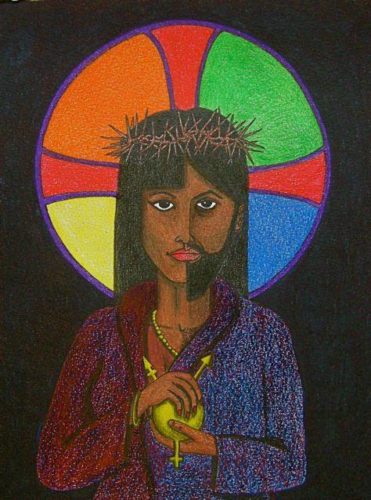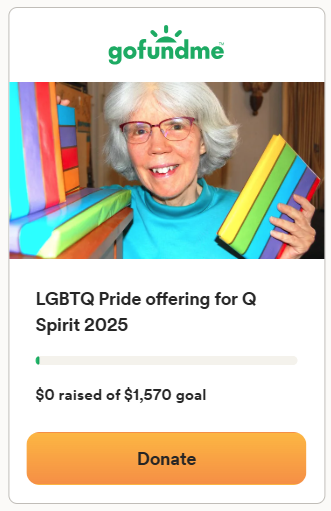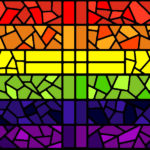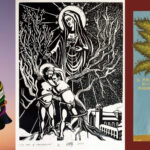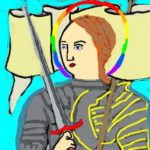Last Updated on April 24, 2025 by Kittredge Cherry
Liberating visions of Jesus as black, Latinx, Native American or female join with the gay Passion of Christ series to help people experience God more fully.
“All people are made in God’s image, so it is important to envision Jesus as queer, black, brown, female and every other human category,” Q Spirit founder Kittredge Cherry said. “The struggle for LGBTQ equality intersects and overlaps with movements for racial, economic, environmental and gender justice. I encourage everyone to explore multiple different non-traditional ways to see Christ.”
Artists have created Christ figures of many races, including Black, Latinx, and People of Color (BIPOC). Woman Christ art focus on women’s experiences. Some have put Jesus’ last days into the context of today’s suffering and injustice.
It’s almost impossible to find a Christ figure that expresses both LGBTQ identity AND non-white racial / ethnic identity. Artists who create these uncommon treasures include Zeloszelos Marchandt, Andrea Noel, Jeremy Whitner, Doug Blanchard and David Hayward.
This year Q Spirit is continuing its annual tradition of presenting all 24 paintings in the original version of “The Passion of Christ: A Gay Vision” by Douglas Blanchard from Palm Sunday through Easter (April 13-20, 2025). However the white gay male Jesus of Blanchard’s original vision is being supplemented with this article presenting a variety of alternative Christ figures.
“Neither” reveals a queer black Jesus
“Neither” shows a dark-skinned Jesus who is male on one side and female on the other in the style of the Hindu deity Ardhanarishvara. He/she has a rainbow halo and holds a transgender symbol.
The title “Neither” comes from the Bible: “There is neither Jew nor Greek, there is neither slave nor free, there is neither male nor female; for you are all one in Christ Jesus.” (Galatians 3:28). Thus it embodies Kwanzaa principles of unity and faith.
“Neither” was painted by Canadian artist David Hayward, also known as Naked Pastor. The Canadian artist uses gentle humor to open hearts, minds and church doors to LGBTQ people and others who have been excluded. He has a master’s degree in theology and 30 years of pastoral experience. This artwork and many more are available at the Nakedpastor Etsy shop. Click for more cartoons and info.
New art shows Jesus as a queer person of color
Two new series that portray Jesus as a queer person of color were introduced on Q Spirit in March 2024.
“Jesus was a Black and Indigenous Trans God….And so am I,” writes performance artist Mx. Zeloszelos Marchandt in an Instagram post explaining his 2023 “Ecce Homo” series. The photo series documents Marchandt using his own body to express Christ’s oneness with people of color and LGBTQ people. “Ecce homo” is Latin for “Behold the man,” the words spoken by the governor when he presented the bound and beaten Jesus to the crowd. But in modern slang it can also refer to homosexuality. Based in Oregon, Marchandt is a multidisciplinary creator whose work often focuses on sex, gender, race, and social history.
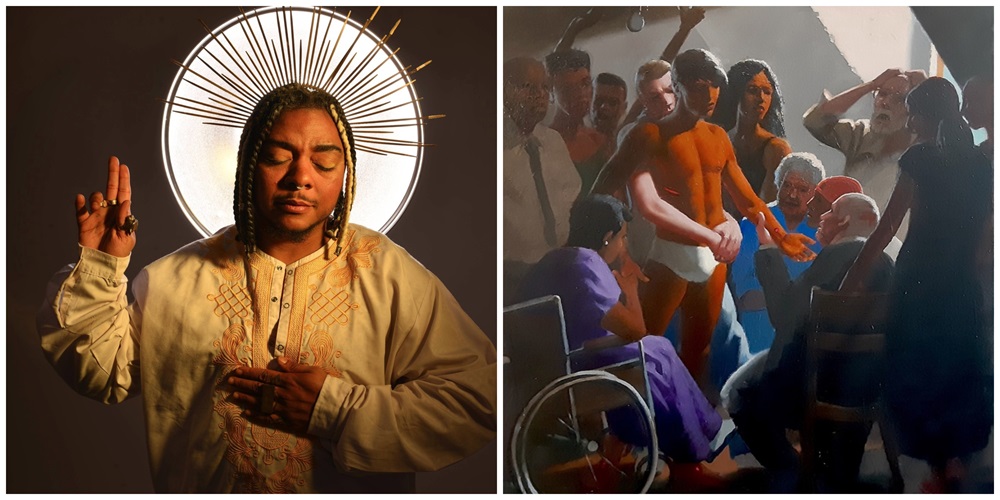
Left: Photo from “Ecce Homo” by Mx. Zeloszelos Marchandt. Photo by Max Hinz. Right: “Jesus Appears to His Friends” from “The Passion of Christ: A Gay Vision” (The Large Passion) by Doug Blanchard.
Jesus is a contemporary man of color in gay Passion of Christ paintings by artist Doug Blanchard. He expands and builds upon the success of his first version of “The Passion of Christ: A Gay Vision” with a new series of 20 larger paintings. The Large Passion features a dark-skinned Jesus, his diverse friends, subtle homoeroticism and powerful new imagery. Jesus and his community live in a black-and-white world for his Last Supper, arrest and crucifixion, but it bursts into color when he rises from the dead. Prints of the Large Passion are being released for first time ever in April 2025. Click for more info or view all 20 paintings.
Queer black Christ figures are among the AI-generated images that re-envision the Stations of the Cross in “Vía Cruising: Queerizando el Escándalo de la Cruz” (Queering the Scandal of the Cross),” a 2023 illustrated article in Spanish by Latinx theologians Hugo Cordova Quero, Anderson Fabián Santos Meza, David de Jesús de Pascual, and Cruz Edgardo Torres. It was published in the journal “Conexión Queer: Revista Latinoamericana y Caribeña de Teologías Queer.”
Black Christ affirms LGBTQ people in “Jesus for All”
A black Christ welcomes LGBTQ people in “Jesus for All” by Andrea Noel, an Afro-Caribbean artist based in Baltimore. Her Jesus expresses queer solidarity through bright rainbow colors that stream from the head of Christ. The rainbow rays include LGBTQ symbols: linked female signs, linked male signs and a transgender symbol. This Jesus has dreadlocks and dark skin marked with lighter streaks that unite him with all races. He is surrounded by dynamic patterns inspired by Noel’s Trinidadian roots.
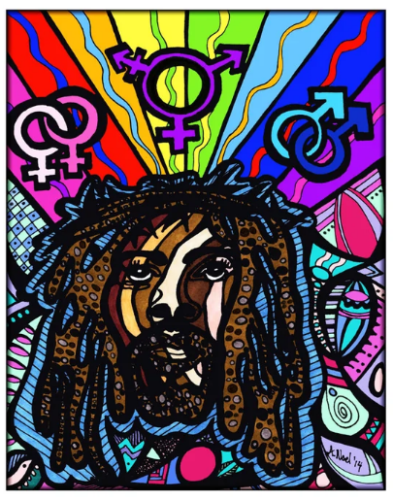
“Jesus for all” by Andrea Noel
She is a self-taught artist, born in Selma, Alabama, but raised in Trinidad and Tobago. Noel developed her artistic style 20 years ago by drawing with Sharpie markers to reduce stress from her demanding classes as a chemical-engineering student at Howard University in Washington, DC.
“Over time, drawing moved from a stress reliever, to a spiritual practice, and now my life’s work,” Noel writes on her website anoelcreatesart.com. “… My goal as an artist is to inspire customers and clients to manifest the passions inside of them that will nurture soulful connections to self, others, and the Sacred.”
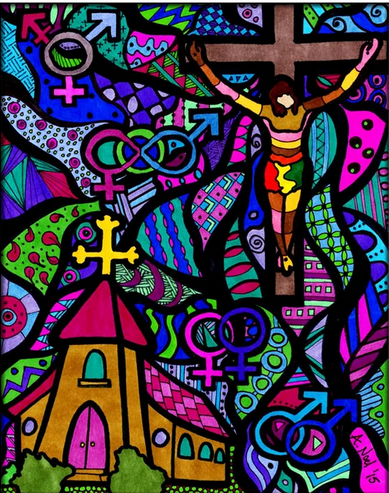
“To Include and Affirm” by Andrea Noel
She portrays a multi-racial Jesus on the cross with lesbian, gay, transgender and heterosexual symbols in “To Include and Affirm.” His skin is a patchwork of different colors, but his loincloth has the green, yellow and red that are associated with many African flags.
Her art is available as prints on her website and at her Etsy shop: A Noel Creates. She illustrates a variety of themes, including social justice, LGBTQ, women, spirituality, and Christianity. Noel agreed to share more of her art with Q Spirit, so watch for it in the future here on the Q Spirit blog.
Queer Asian Jesus prays alone
Artists have created a variety of queer Asian Christ figures. Some are related to Kuan Yin, the genderfluid spirit of compassion in Buddhism. A different kind of queer Asian Christ figure is portrayed in “Jesus Prays Alone” by Jason Antiquera, a Catholic missionary priest from the Philippines who works on mission in South Korea. He relocates the gospel story of Jesus praying alone in agony before his arrest. Instead of the garden of Gethsemane, the contemporary Asian Christ prays in Itaewon, an LGBTQ neighborhood in Seoul, South Korea.
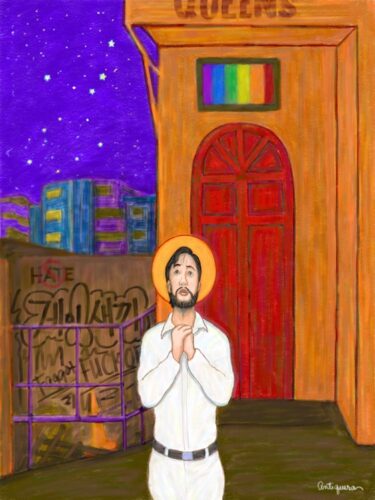
“Jesus Prays Alone” by Jason Antiquera
Click here for more info on this and other LGBTQ Asian visions of Jesus.
“Rainbow Christ-Sophia” expresses solidarity
A dark-skinned Jesus with a rainbow halo appears in a 2022 series of Passion-themed paintings by North Carolina artist Jeremy Whitner. He is a queer Christian iconographer in process for ministry with the Disciples of Christ while attending Union Presbyterian Seminary in Charlotte. Prints and other items with his artwork are available through his shops at Fine Art America and Pixels.
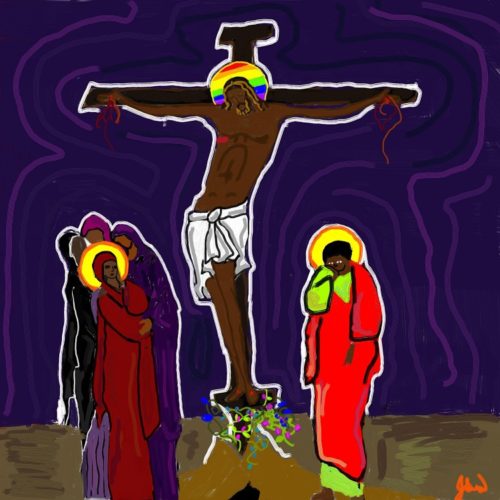
“The Crucifixion of the Rainbow Christ-Sophia” by Jeremy Whitner.
In the titles to the paintings, Whitner refers to this Jesus as “Rainbow Christ-Sophia.” The name evokes Christ’s solidarity with women and the LGBTQ community, whose symbol is the rainbow flag. Sophia is Greek for “wisdom” and represents the female incarnation of Wisdom in the Bible (Proverbs 8:22-31). Sophia has been interpreted as a Christ figure since the early church, and she has appeared in Byzantine churches and icons at least since the Middle Ages. The dark skin of this Jesus speaks for itself to express Christ’s solidarity with people of color. The rainbow Christ-Sophia stands for and suffers with people who are oppressed for any reason, including LGBTQ people. Whitner was inspired to by the Rainbow Christ Prayer when he began painting his Rainbow Christ-Sophia series.
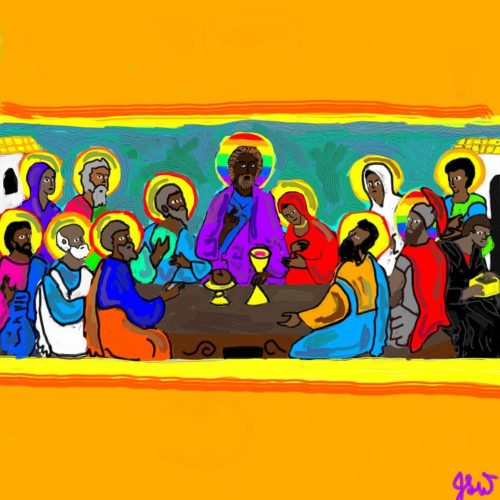
“Do This in Remembrance of Me” by Jeremy Whitner includes the centurion with a rainbow halo.
The dinner crowd in Whitner’s version of the Last Supper includes a surprising figure with a rainbow halo: the gay centurion who asked Jesus to heal his same-sex lover. The centurion can be identified by his rainbow halo and the red crest on top of his helmet. It’s unusual to picture the centurion at the Last Supper, but Whitner believes he joined the other disciples at the Passover meal because of his faith in Jesus. “When I consecrate communion I always make of point of saying the centurion was probably there, along with the woman with the issue of blood,” Whitner told Q Spirit.
As Jesus hangs on the cross, his dark skin almost merges with the black background in “The Crucifixion of the Rainbow Christ-Sophia” by Jeremy Whitner. The gospels report “there was darkness over all the land” for three hours before Jesus died. In a similar way, only a thin white outline separates Jesus’ skin from the dark sky in the crucifixion as he pictures it.
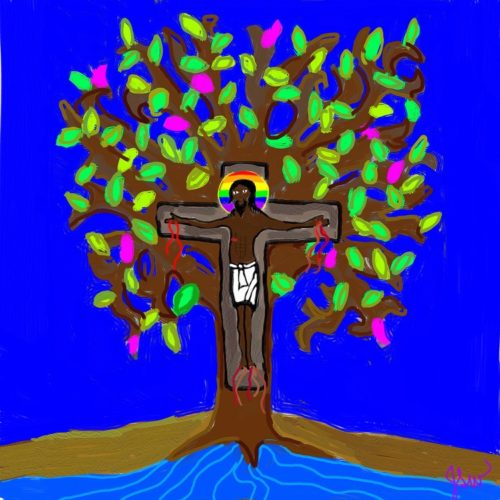
“Jesus, Christ-Sophia the Liberator, Tree of Life” by Jeremy Whitner shows Christ with a rainbow halo crucified on a tree symbolizing the meeting place for heaven and earth.

“La Pieta of the Christ-Sophia” by Jeremy Whitner portrays rainbow Mary grieving as she holds the body of her dead son
Whitner also painted “The Resurrection of the Rainbow Christ-Sophia,” which was posted on Q Spirit for Easter 2022, and a rainbow Madonna and Christ child, which is included in Q Spirit’s Rainbow Mary roundup.
More resources to envision Jesus in nontraditional ways
The following links offer a variety of alternative visions.
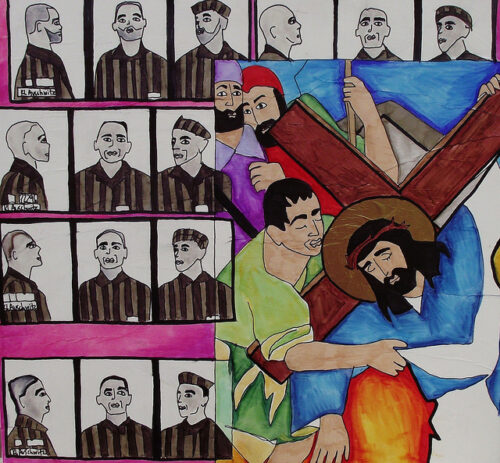
“Station 3: Jesus falls the first time / 1933: Nazis ban homosexual groups” by Mary Button
LGBT Stations of the Cross shows struggle for equality features Kittredge Cherry’s reflections on art by Mary Button. She has also painted the Stations of the Cross in the context of other contemporary issues such as climate change, immigration, refugees, mass incarceration, mental illness, Syria and the COVID-19 pandemic.
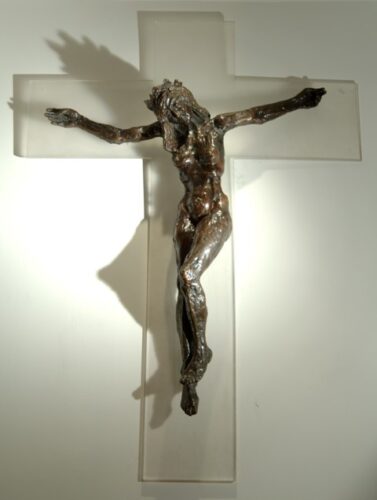
“Christa” by Edwina Sandys
“Christa” a crucified female Christ sculpture by British artist Edwina Sandys. It is featured in the book “Art That Dares: Gay Jesus, Woman Christ, and More” by Kittredge Cherry.
“Stations of the Cross” with a black Jesus by Vermont artist Janet McKenzie. Also available as a book, “The Way of the Cross: The Path to New Life,” with reflections by Joan Chittister, a Benedictine nun and champion for justice.

Station 15 from “The Stations of the Cross: The Resurrection,” copyright 2013 Janet McKenzie. www.janetmckenzie.com Used with permission.
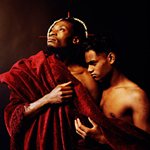
“Every Moment Counts” (from “Ecstatic Antibodies”) by Rotimi Fani-Kayode
Jesus and his Beloved Disciple are presented as black Africans in “Every Moment Counts” (from “Ecstatic Antibodies”) by Rotimi Fani-Kayode (1955-1989). He was a Nigerian photographer who explored themes of sexual and cultural difference, homoerotic desire, spirituality and the black male body, often in collaboration with his late partner Alex Hirst. Their last joint work was “Every Moment Counts” from 1989. In it the Beloved Disciple leans against black Christ figure who wears pearls over his dreadlocks as he gazes toward heaven. It has been exhibited widely, including in “Transcendence: A Century of Black Queer Ecstasy, 1924-2024” at the Art Galleries at the University of Texas at Austin in 2024.
Latin American Stations of the Cross by Adolfo Perez Esquivel, Argentine human rights activist and Nobel Peace Prize winner.
Native American Stations of the Cross by Melanie Twelves, member of All Saints Episcopal Church in Duncan, Oklahoma.
Religious art by William H. Johnson, early 20th-century African American artist whose body of work is at the Smithsonian, includes “Jesus and the Three Marys,” “Mount Calvary” and “Lamentation.”
Portraits of a black Jesus by Kehinde Wiley, African American artist who painted President Obama for the Smithsonian.
Women’s Way of the Cross by Ohio artist Julie Lonneman emphasizes the role of women.
Books for envisioning Jesus in nontraditional ways
Recommended books for further reading include:
“Art That Dares: Gay Jesus, Woman Christ, and More” by Kittredge Cherry.
“Rainbow Theology: Bridging Race, Sexuality, and Spirit” by Patrick Cheng.
“A Black Theology of Liberation” by James Cone.
“Seeking the Risen Christa” by Nicola Slee.
“A Theology of Liberation” by Gustavo Gutierrez.
“Preaching as Resistance: Voices of Hope, Justice, and Solidarity.” 30 sermons on LGBTQ equality, racial justice, climate protection and more, edited by Phil Snider.
___
Top image credit:
Top: “Neither” by David Hayward.
___
This article was originally published on Q Spirit in March 2021, was expanded with new material over time, and was most recently updated on April 24, 2025.
Copyright © Kittredge Cherry. All rights reserved.
Qspirit.net presents the Jesus in Love Blog on LGBTQ spirituality.

